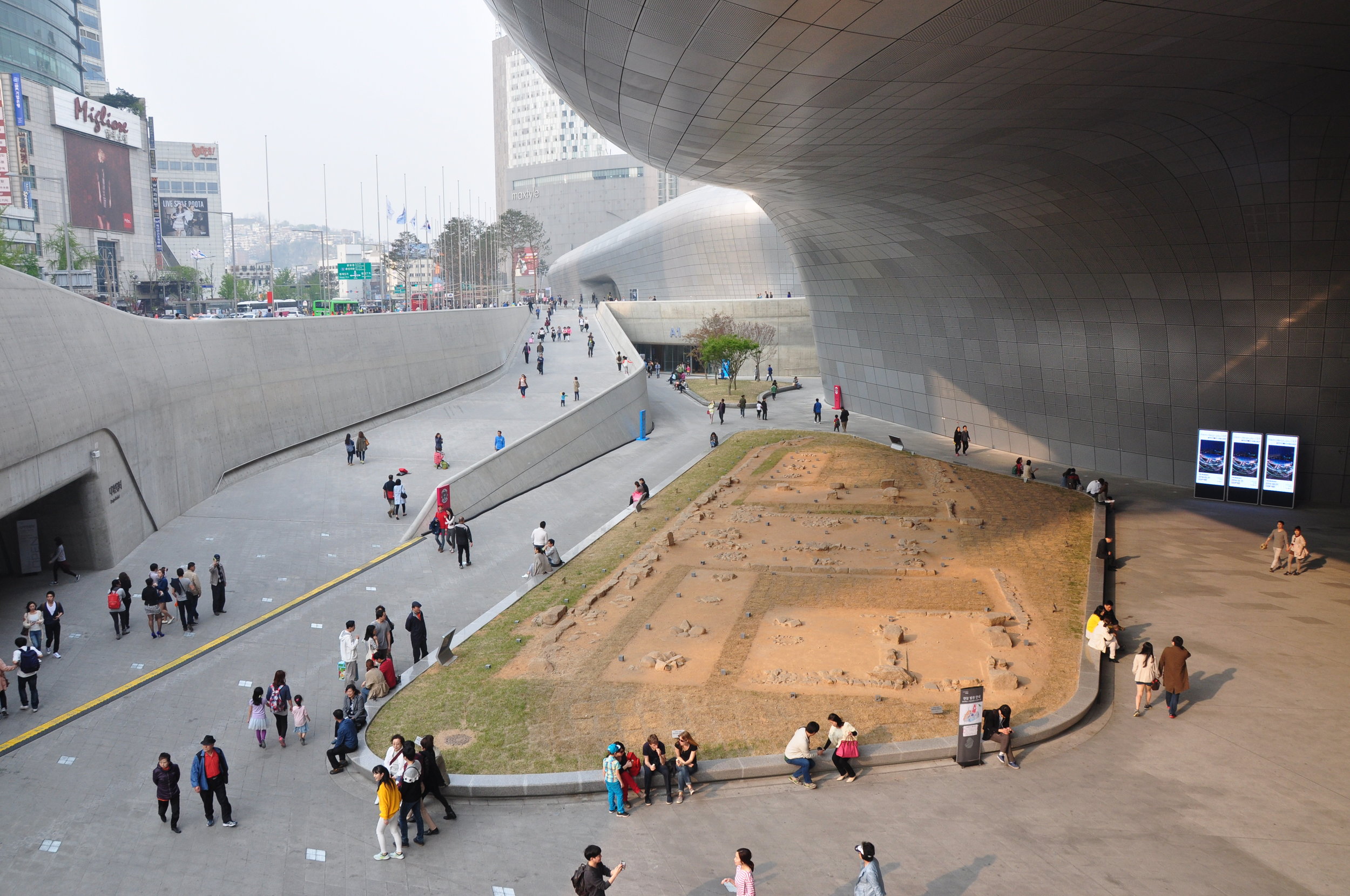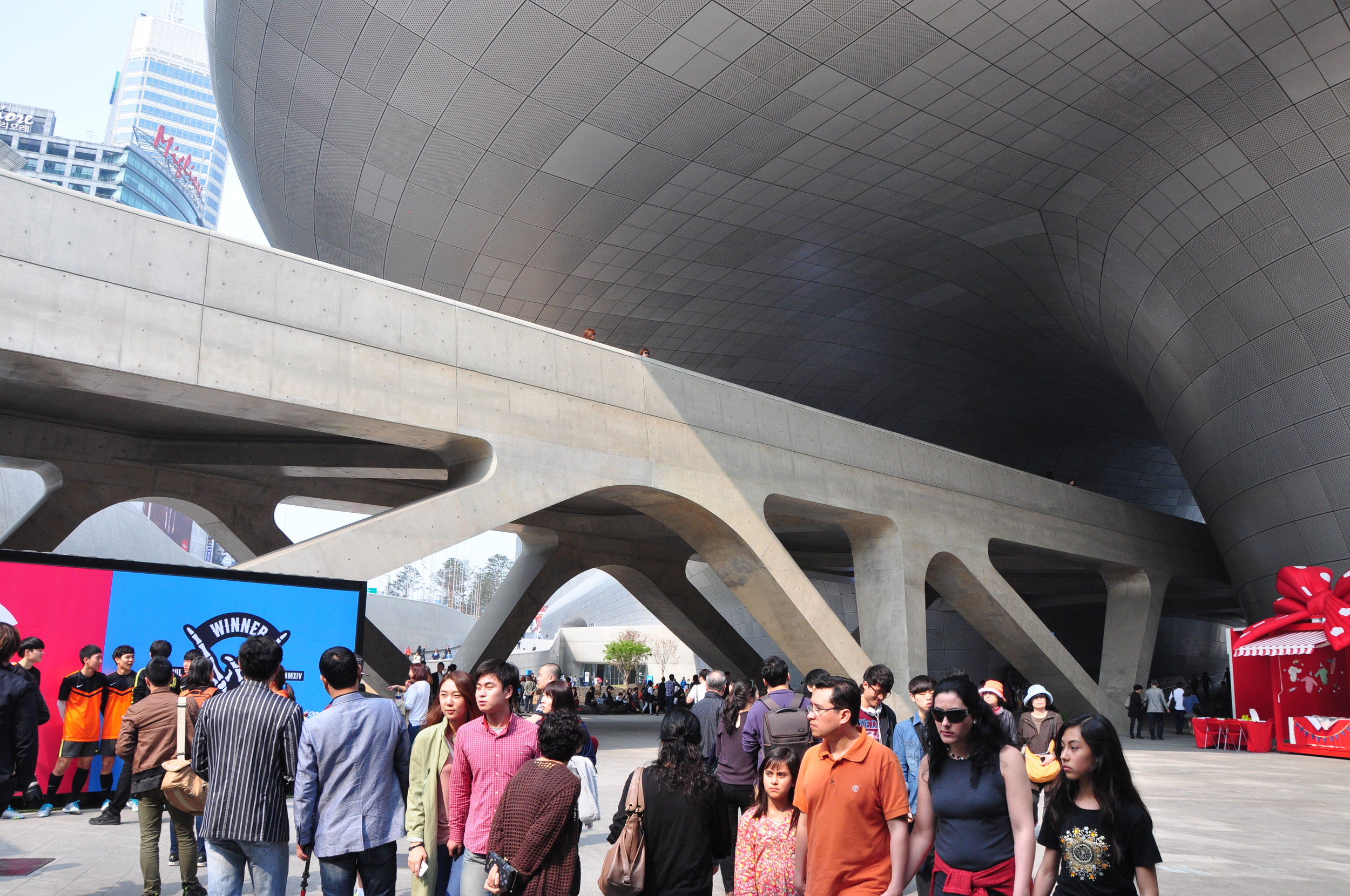Future as Past: Zaha Hadid's New Dongdaemun Design Plaza

 Finding myself lost within the sinuous darkened hallways of Zaha Hadid's new Dongdaemun Design Plaza in Seoul, it is easy to see how Ms. Hadid could state casually that it was not her responsibility to consider the condition of the exploited migrant workers building her World Cup Stadium in Qatar, nearly 1000 of whom have already died. For she seemed to render the same sense of judicious indifference towards this building's end users.
Finding myself lost within the sinuous darkened hallways of Zaha Hadid's new Dongdaemun Design Plaza in Seoul, it is easy to see how Ms. Hadid could state casually that it was not her responsibility to consider the condition of the exploited migrant workers building her World Cup Stadium in Qatar, nearly 1000 of whom have already died. For she seemed to render the same sense of judicious indifference towards this building's end users.
That was at least the feeling I had, as I found myself lost within the bowels of the new "cultural complex" cum shopping and museum space that recently opened in central Seoul. While certainly a dramatic new addition to Seoul's growing reputation as a city of the future, the vast expanse of polished curving steel also instilled a palpable unease within me as I strolled its grounds and exhibition spaces, hoping to find something interesting that might point to the city's arrival as a cultural center.
As I entered the complex from the subway, I found myself in an underground shopping concourse, replete with expensive coffee shops and a few brand stores. It doesn't seem to bode well for the rest of the "cultural complex". The majority of the buildings are indeed occupied by exhibition spaces, only some of which are open as of now. A large "design space" houses stalls selling rather overpriced items designed by local artists and others, as well as a bookstore featuring art and architecture books, a travel store selling $20 passport covers. Being ushered in by attendants selling tickets to various exhibitions, a Nike-sponsored indoor soccer match, it is clear that the DDP is not really a public space, although its realization came at the cost of $450 million to Seoul taxpayers.
The curvilinear lines that form the pattern language of the site harken back to the futuristic space age aesthetic of 1950's America. Ironically as it reaches into the future, it also stretches back to other optimistic eras in which a vision of the future was meant to instill wonder, whimsy, and even fear in the people who experienced the space. Zaha Hadid and her distinctly futuristic aesthetic are thus aptly suited to the spirit of rising Asian countries who have embraced her wildly curving architecture as an expression of their new economic dynamism and optimism. Yet, in the interior spaces and wide open plazas that cower under sweeping overhangs of concrete, one can also feel the sinister weight of a system that has failed to consider the actual people who will use and inhabit the spaces, let alone the ones who build them.
There are, to be fair, several nods to local history: the light fixtures of the old Dongdaemun baseball stadium whose demolition made way for the current complex, a few areas of exposed stone showing what used to be the Seoul city wall dating from the imperial Joseon period (1392-1910). Yet, these gimmicky nods to history and culture don't sit well with the overall scale and mood of the site. They are, at best, awkward perfunctory responses to criticism of the plaza as a giant alien spaceship. But they don't make the site any less alien, or less spaceship-like.
My biggest complaint with the structure itself is the interior. The impressive steel facade does not make any attempt to allow light into the interior spaces, making for dizzying, claustrophobia-inducing hallways that seem to wrap endlessly between the exhibition spaces, depositing visitors unexpectedly into other parts of the site with little signage or explanation. The sense of directional confusion it created in me seems an apt metaphor for the confusion of the structure itself: not sure as to whether it should be a mall, a museum, a giant coffee shop, or a genuine public space for creative expression, the latter being the least suitable of those categories.
A true spirit of design and creativity can be readily found in other parts of the city: in the alleys filled with pubs and boutiques in student-mecca Hongdae, or in the renovated gallery district in Bukchon, an old residential quarter of Seoul near the imperial palaces. But Dongdaemun Design Plaza is less about design than it is about dollars, as are most urban mega-projects these days.
Of course, putting grand scale and overpowering effect ahead of human-scale design is not unique to the Dongdaemun Design Plaza, nor to Zaha Hadid. In many ways, the creation of a large public space should be a welcome addition to a city currently lacking in large public spaces of any sort. It is, however, unfortunate that the end result does not seem to say anything remotely interesting about the site, or about Seoul or Korea. The plaza, like much starchitecture, could be found in any large "global city" of the 21st century. The most it can say about its city Seoul is that it has the ambition and drive to build such public spaces even as much of the developed world shies away from such large-scale projects.
In recent years however, Seoul has embarked on ambitious projects to remake its city center into a greener, more human-centered environment. It has torn down concrete viaducts and overpasses that marked the rapid industrialization of the 1960's under strongman Park Chung-Hee. Trees have been planted, and sidewalks improved. The muscular concrete modernist aesthetic of the Dongdaemun Design Plaza, however, is an incongruous ode to that seemingly far-off era. It ignores the city's recent shift towards human-centered urban space. The Dongdaemun Design Plaza, while futuristic on the surface, is actually quite anachronistic, even kitschy in its wild embrace of the big and the overbearing at the expense of the small-scale and the friendly Seoul.
Zaha Hadid, see: http://www.archdaily.com/480990/zaha-hadid-on-worker-deaths-in-qatar-it-s-not-my-duty-as-an-architect/
Photos: Andrew Stokols, and Feng Yan


